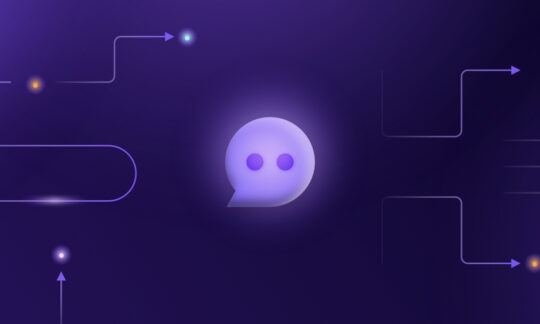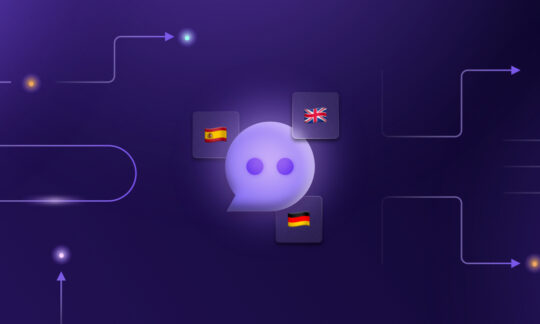Key Challenges in Voice Bot and Chatbot Building and How to Overcome Them
Table of contents
- Top Challenges in Developing Chatbots and Voice Bots
- Overcome Any Challenge with SentiOne Automate
- Article Summary
Not many people are aware of the potential challenges that come up during AI chatbot development. In this part of our Bot Building Series, we’ll take a look at some of those tricky-to-navigate speedbumps chatbot developers should keep an eye out for, and show you how to improve chatbot accuracy with solutions to each and every one of those problems.
Top Challenges in Developing Chatbots and Voice Bots
1. Training Your Language Model Correctly
Nothing is more frustrating for users than a chatbot that acts as if it lived on another planet. If your AI assistant cannot understand your customers, it’s not useful. Your chatbot will only be as good as your dataset. Effective chatbot design should involve making data-driven decisions, which requires time spent on conversation mining, looking into conversation transcripts, and properly training the chatbot so that it understands the customer experience, and doesn’t spread misinformation or cause user frustration.
Solution: Don’t fall into the trap of going “by feel.” Dig into user transcripts, aim to create a chatbot that knows how to speak to your users and ask the right questions. Also, keep a close eye on things and review your NLU model periodically. Accuracy reports and confusion matrix are fantastic ways of identifying potential setbacks in your NLU’s performance, as well as pinpointing ways to improve it. Sounds like a lot of work, and it is, though you can ease that burden a little by building your chatbot with SentiOne Automate and relying on our high-fidelity pre-trained language models.
2. Proper Design of Processes and Dialogue Flows
Even when you design your conversations using the right linguistic nuance and phraseology your customers are familiar with, things can still go awry if the step-by-step process accidentally leads them to conversational dead ends. To avoid improper chatbot UX, its dialogue should flow, not stumble and crash, lest you frustrate your users with an avalanche of errors and misunderstood intents.
Solution: Plan for failure and have backups in place. Supplement your chatbot’s conversation flows with messages that explain what went wrong and why, and offer the customer a way to go back to an earlier point in the exchange. Your flow shouldn’t ever just abruptly end, there always needs to be a way out, including by simply transferring the conversation to a live agent. The Flow Builder in SentiOne Automate is the perfect solution for this. You can use it to set up block types that handle failures, such as wrong inputs or lack of understanding. They can act as backups, inform users of what went wrong and put them back on the right path. You can set up your bot to say “I’m sorry could you please repeat XYZ”, or “I don’t understand exactly. Did you mean Y or Z?”. The bot can use the context of the conversation, including previous messages to coin these questions and help guide users. The Flow Builder allows for multiple strategies – even if your bot fails to understand the user after a few attempts, it will either restart or transfer them to a human agent.
3. Overcoming Customers’ Mistrust Towards Bots
Ask any random person on the street if they trust chatbots and chances are they’ll say no 9/10 times. Cognizant’s study revealed that only 22% do place trust in them, but that number is probably skewed by the more tech- and Internet-savvy demographic. So the point still stands, as is expected, considering the rocky reputation chatbots and voice bots have earned in their early days. Despite how sophisticated the technology has become over the years, in most people’s minds, voice bots are still the annoying and unhelpful IVR voice (which, worth noting, is decidedly not the same as a voice bot) or a script that can’t properly recognise intent. Unsurprisingly, encouraging your customers to interact with your bot is one of the biggest challenges in chatbot development.
Solution: Breathe life into your chatbot with a purposeful and human-like design. Embellish it with a personality and tone of voice that matches your brand identity. Invest time into making both the chatbot UI and the overall user experience hassle-free. Keep tweaking it and track its performance to verify areas in need of improvement. Make sure your clients know what the bot can and cannot help with, preferably at the beginning of the conversation. Remember, the key to long-term chatbot effectiveness lies in continuous improvement.
4. Establishing Actionable Long-Term Goals
A directionless approach to chatbot testing and development only breeds mistakes down the line. Expecting it to perform without actually tracking its performance is a recipe for disaster, as both you and your clients will gradually lose your mind when trying to figure out what’s going wrong when using the chatbot. Without a number of business-oriented goals, you can’t measure the chatbot’s effectiveness or its ROI, and can’t communicate internally across teams and stakeholders to focus on relevant KPIs.
Solution: Broadly speaking, your chatbot’s goals should be aligned with your overarching business goals. To that end, it’s crucial to observe the right metrics and train your chatbot. Verify the right areas for optimisation, such as user metrics (automation rate, bounce rate, retention time, CSAT scores etc.) or business metrics (conversions, % of successful upselling, leads generated). Also, ask for feedback directly from the source – setting up a simple survey after each chatbot interaction isn’t too heavy-handed and yet provides invaluable insight.
5. Providing Adequate Language Support
How much do you know about your users? You’re probably well aware of what language is used by the majority of your user base, but what about the second most used? What about the third? Not all businesses will need to use this, but if your company operates internationally, not paying attention here means you’re limiting the quality of the customer experience.
Solution: Analyse what countries your customers come from and see if implementing multilingual support for your chatbot could bring additional value. Expanding your chatbot’s NLU capabilities to offer support for each language spoken by your users can unlock new revenue streams. We dive deeper into the topic of perfecting your NLU in our next article, but if you’d like to take action now, SentiOne Automate comes fully equipped with pre-trained multi-language NLUs that can achieve up to 96% intent recognition accuracy in Polish, English, Arabic, Italian, German, Spanish, and French, making your chatbots and voice bots feel and sound nearly indistinguishable from humans!
6. Security Concerns
Prioritising chatbot security is a necessity in a range of industries, for example in the banking sector. Any institution that doesn’t safeguard its clients’ private and sensitive information tempts fate, as even minor incidents will shatter its reputation completely, on top of hefty fines slapped on by regulatory bodies. A significant challenge of chatbots involves providing that sufficient level of safety, no matter the cost.
Solution: Put considerable thought into your information security and make sure your methods and measures have fail-safes in place. Depending on where your business is operating and who your clients are, you may be subject to rigorous data protection standards, such as GDPR or ISO compliance. In addition, don’t forget to account for third-party software your company uses to process customer data, and enact appropriate measures to prevent leaks and breaches on those fronts, too. OpenAI, for example, claims to be fully compliant with many security standards, though with the rapid development going on in the field of artificial intelligence at present, there’s always the possibility of other options emerging that won’t place sufficient stress on data security. Lastly, if your systems don’t authenticate users via 2FA, its way past due you introduced that as a requirement, especially if your chatbot is deployed on unencrypted channels like Facebook Messenger, as opposed to encrypted ones like WhatsApp.
7. Limitations of Speech Recognition Tech
The technology may not be in its infancy, but it has a bit of a way to go before it reaches perfection. As in the case of chatbots, the field is developing at breakneck speed, with projections estimating the market size to grow to almost $60 billion by 2030. Big numbers aside, according to this survey, 73% of respondents cite accuracy as the leading barrier to the adoption of voice technology. Companies have been steadily reducing their WER, or Word Error Rates, though there is one other problem – an enormous bias toward English speakers. Most companies in the sector are based in the US, and not all of them develop their software while accounting for various accents (both native and non-native English), informal speech, or environmental contexts, such as a speaker’s noisy surroundings, poor microphone quality, or other people speaking in the background.
Solution: Choose a speech recognition software provider with a verifiably good track record and low WER. A good fit should also focus on constantly evolving the software’s capabilities and ideally give you customisation options, so that you may tweak and train your speech recognition technology to adapt to your customers.
8. Problematic Inputs
Some words or phrases, such as names or strings of numbers, will naturally be difficult for the voice bot to recognise and process properly. Accuracy can be lost at any point, and when you factor in accents or background noise as we mentioned already, names get easily confused, and twos become fours.
Solution: For those tricky inputs such as names and numbers contact centres use keypad inputs for better accuracy over the phone, or send out an SMS or message on the app of the business, e.g. to register user’s details or make a payment.
9. Reading Emotions
Voice bots often struggle with sensing the emotions, urgency, or even the age of the person calling. This can lead to increasingly frustrating experiences if a customer is calling in about a serious security issue but is greeted by an abnormally calm and oblivious voice bot. Contextual mismatches like this are a crucial point of friction that needs to be resolved.
Solution: Train your voice bot to identify a caller’s emotions, moods, and other key characteristics ( e.g., when a user starts cursing or calling the bot names). Always have a framework in place to handle customers who are frustrated, lost, confused, or unfamiliar with your business, and make sure the voice bot adjusts its communication style to the given situation.
Overcome Any Challenge with SentiOne Automate
Now you know that the road ahead is rife with obstacles. SentiOne Automate can help you navigate them easily. If you’re curious and want to learn more, see other articles in the Bot Building Series, or book a demo today – our team would love to show you around!
Article Summary
This article discusses the main challenges of chatbot development. It outlines problems typically encountered by bot designers and offers adequate solutions to improve chatbot accuracy. The article explains how to deal with chatbot/voice bot design and testing, and how to address mistrust and security concerns, among others.



